Literature Review: A Conceptual Framework for Tourism in Mountains
VerifiedAdded on 2023/06/12
|22
|11653
|57
Literature Review
AI Summary
This literature review delves into a conceptual framework designed to address tourism and recreation in mountainous regions. It begins by outlining six mountain-specific resource characteristics: diversity, marginality, difficulty of access, fragility, niche, and aesthetics, arguing that these unique features significantly impact mountain recreation and tourism development. The review then examines the evolving landscape of recreation and tourism in mountains, particularly the increasing demand from local recreationists, tourists, and amenity migrants, and the implications for planning and management. A three-class system of recreation and tourism land-use settings—nodal center, frontcountry, and backcountry—is proposed to resolve the challenges arising from the diverse needs of these users. The framework emphasizes that effective tourism planning and management in mountainous regions must consider and integrate these mountain-specific resource characteristics. Ultimately, the review posits that this framework not only fosters an integrated perspective on mountain tourism planning and management but also propels research in areas concerning mountain resource characteristics, amenity users, and recreational zoning.
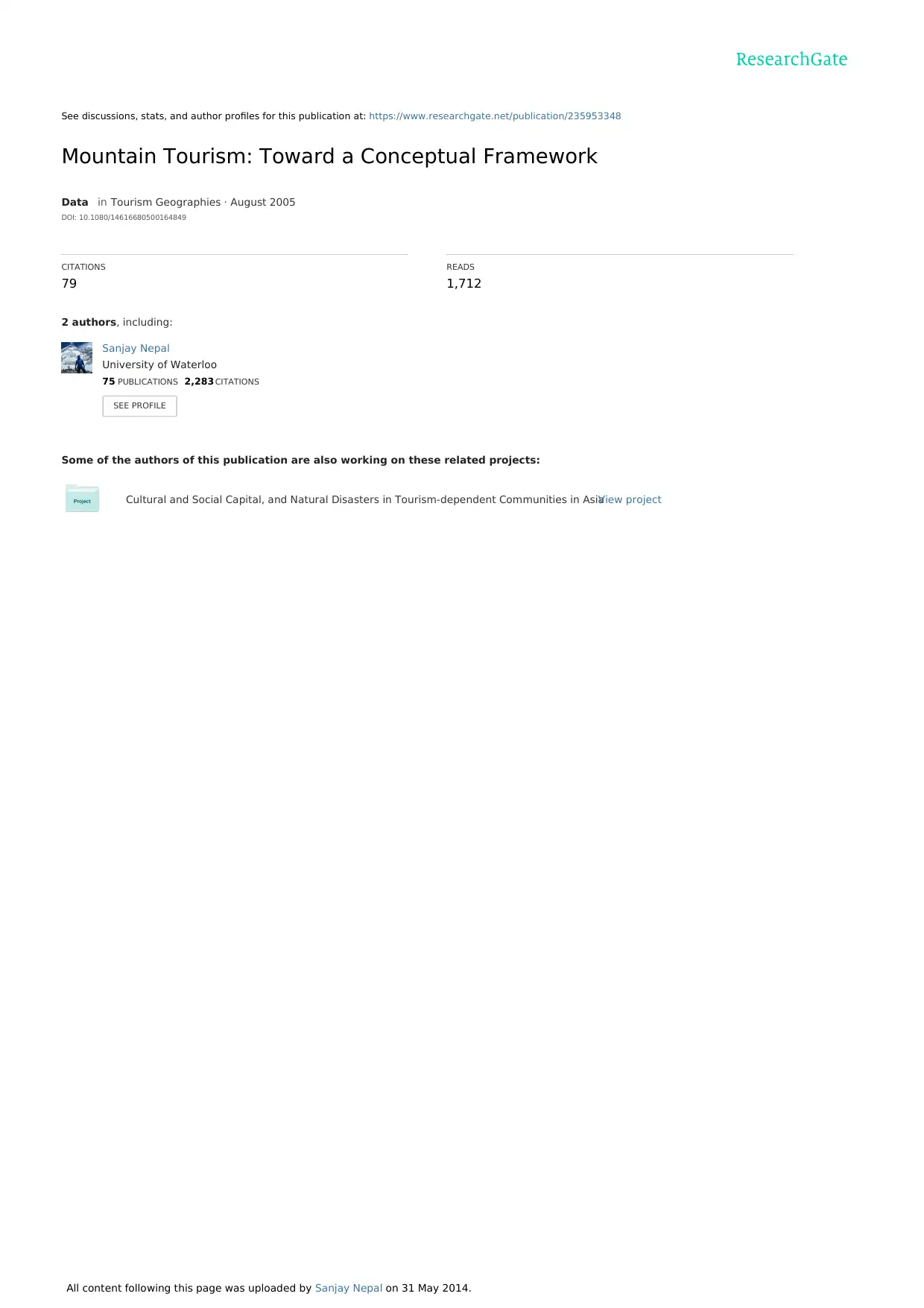
See discussions, stats, and author profiles for this publication at: https://www.researchgate.net/publication/235953348
Mountain Tourism: Toward a Conceptual Framework
Data in Tourism Geographies · August 2005
DOI: 10.1080/14616680500164849
CITATIONS
79
READS
1,712
2 authors, including:
Some of the authors of this publication are also working on these related projects:
Cultural and Social Capital, and Natural Disasters in Tourism-dependent Communities in AsiaView project
Sanjay Nepal
University of Waterloo
75 PUBLICATIONS 2,283 CITATIONS
SEE PROFILE
All content following this page was uploaded by Sanjay Nepal on 31 May 2014.
Mountain Tourism: Toward a Conceptual Framework
Data in Tourism Geographies · August 2005
DOI: 10.1080/14616680500164849
CITATIONS
79
READS
1,712
2 authors, including:
Some of the authors of this publication are also working on these related projects:
Cultural and Social Capital, and Natural Disasters in Tourism-dependent Communities in AsiaView project
Sanjay Nepal
University of Waterloo
75 PUBLICATIONS 2,283 CITATIONS
SEE PROFILE
All content following this page was uploaded by Sanjay Nepal on 31 May 2014.
Paraphrase This Document
Need a fresh take? Get an instant paraphrase of this document with our AI Paraphraser
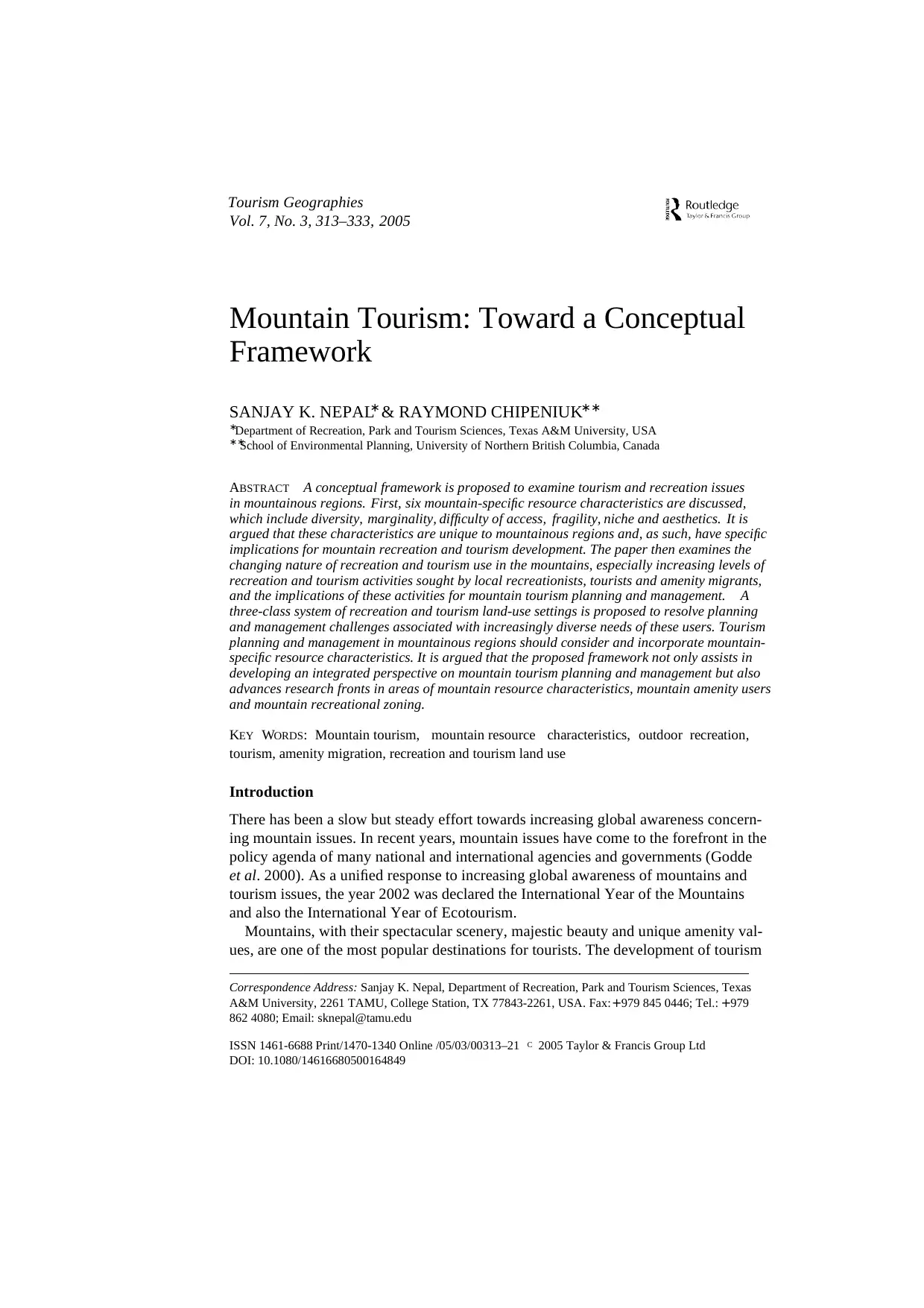
Tourism Geographies
Vol. 7, No. 3, 313–333, 2005
Mountain Tourism: Toward a Conceptual
Framework
SANJAY K. NEPAL∗ & RAYMOND CHIPENIUK∗∗
∗Department of Recreation, Park and Tourism Sciences, Texas A&M University, USA
∗∗School of Environmental Planning, University of Northern British Columbia, Canada
ABSTRACT A conceptual framework is proposed to examine tourism and recreation issues
in mountainous regions. First, six mountain-specific resource characteristics are discussed,
which include diversity, marginality, difficulty of access, fragility, niche and aesthetics. It is
argued that these characteristics are unique to mountainous regions and, as such, have specific
implications for mountain recreation and tourism development. The paper then examines the
changing nature of recreation and tourism use in the mountains, especially increasing levels of
recreation and tourism activities sought by local recreationists, tourists and amenity migrants,
and the implications of these activities for mountain tourism planning and management. A
three-class system of recreation and tourism land-use settings is proposed to resolve planning
and management challenges associated with increasingly diverse needs of these users. Tourism
planning and management in mountainous regions should consider and incorporate mountain-
specific resource characteristics. It is argued that the proposed framework not only assists in
developing an integrated perspective on mountain tourism planning and management but also
advances research fronts in areas of mountain resource characteristics, mountain amenity users
and mountain recreational zoning.
KEY WORDS: Mountain tourism, mountain resource characteristics, outdoor recreation,
tourism, amenity migration, recreation and tourism land use
Introduction
There has been a slow but steady effort towards increasing global awareness concern-
ing mountain issues. In recent years, mountain issues have come to the forefront in the
policy agenda of many national and international agencies and governments (Godde
et al. 2000). As a unified response to increasing global awareness of mountains and
tourism issues, the year 2002 was declared the International Year of the Mountains
and also the International Year of Ecotourism.
Mountains, with their spectacular scenery, majestic beauty and unique amenity val-
ues, are one of the most popular destinations for tourists. The development of tourism
Correspondence Address: Sanjay K. Nepal, Department of Recreation, Park and Tourism Sciences, Texas
A&M University, 2261 TAMU, College Station, TX 77843-2261, USA. Fax:+979 845 0446; Tel.: +979
862 4080; Email: sknepal@tamu.edu
ISSN 1461-6688 Print/1470-1340 Online /05/03/00313–21 C 2005 Taylor & Francis Group Ltd
DOI: 10.1080/14616680500164849
Vol. 7, No. 3, 313–333, 2005
Mountain Tourism: Toward a Conceptual
Framework
SANJAY K. NEPAL∗ & RAYMOND CHIPENIUK∗∗
∗Department of Recreation, Park and Tourism Sciences, Texas A&M University, USA
∗∗School of Environmental Planning, University of Northern British Columbia, Canada
ABSTRACT A conceptual framework is proposed to examine tourism and recreation issues
in mountainous regions. First, six mountain-specific resource characteristics are discussed,
which include diversity, marginality, difficulty of access, fragility, niche and aesthetics. It is
argued that these characteristics are unique to mountainous regions and, as such, have specific
implications for mountain recreation and tourism development. The paper then examines the
changing nature of recreation and tourism use in the mountains, especially increasing levels of
recreation and tourism activities sought by local recreationists, tourists and amenity migrants,
and the implications of these activities for mountain tourism planning and management. A
three-class system of recreation and tourism land-use settings is proposed to resolve planning
and management challenges associated with increasingly diverse needs of these users. Tourism
planning and management in mountainous regions should consider and incorporate mountain-
specific resource characteristics. It is argued that the proposed framework not only assists in
developing an integrated perspective on mountain tourism planning and management but also
advances research fronts in areas of mountain resource characteristics, mountain amenity users
and mountain recreational zoning.
KEY WORDS: Mountain tourism, mountain resource characteristics, outdoor recreation,
tourism, amenity migration, recreation and tourism land use
Introduction
There has been a slow but steady effort towards increasing global awareness concern-
ing mountain issues. In recent years, mountain issues have come to the forefront in the
policy agenda of many national and international agencies and governments (Godde
et al. 2000). As a unified response to increasing global awareness of mountains and
tourism issues, the year 2002 was declared the International Year of the Mountains
and also the International Year of Ecotourism.
Mountains, with their spectacular scenery, majestic beauty and unique amenity val-
ues, are one of the most popular destinations for tourists. The development of tourism
Correspondence Address: Sanjay K. Nepal, Department of Recreation, Park and Tourism Sciences, Texas
A&M University, 2261 TAMU, College Station, TX 77843-2261, USA. Fax:+979 845 0446; Tel.: +979
862 4080; Email: sknepal@tamu.edu
ISSN 1461-6688 Print/1470-1340 Online /05/03/00313–21 C 2005 Taylor & Francis Group Ltd
DOI: 10.1080/14616680500164849
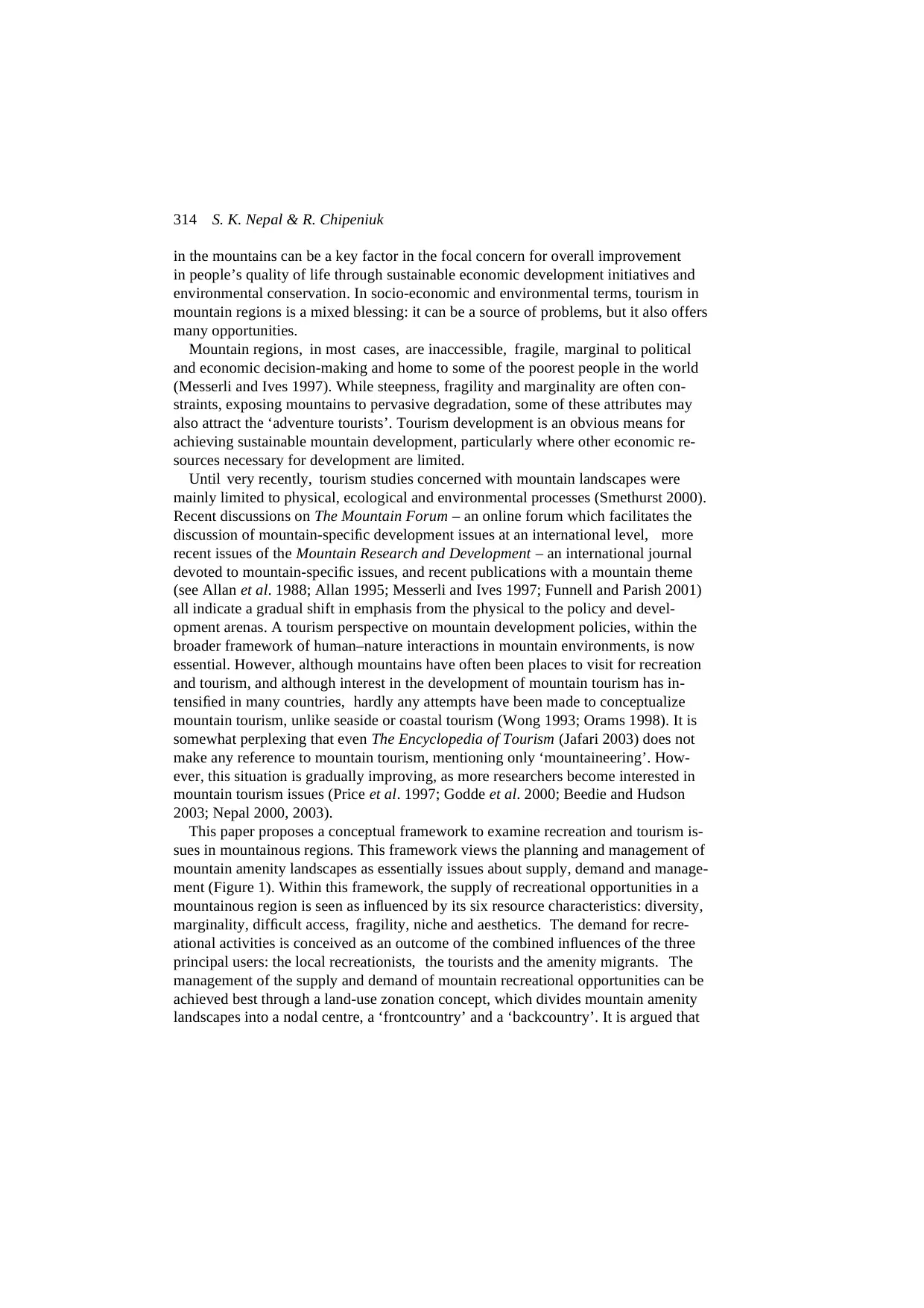
314 S. K. Nepal & R. Chipeniuk
in the mountains can be a key factor in the focal concern for overall improvement
in people’s quality of life through sustainable economic development initiatives and
environmental conservation. In socio-economic and environmental terms, tourism in
mountain regions is a mixed blessing: it can be a source of problems, but it also offers
many opportunities.
Mountain regions, in most cases, are inaccessible, fragile, marginal to political
and economic decision-making and home to some of the poorest people in the world
(Messerli and Ives 1997). While steepness, fragility and marginality are often con-
straints, exposing mountains to pervasive degradation, some of these attributes may
also attract the ‘adventure tourists’. Tourism development is an obvious means for
achieving sustainable mountain development, particularly where other economic re-
sources necessary for development are limited.
Until very recently, tourism studies concerned with mountain landscapes were
mainly limited to physical, ecological and environmental processes (Smethurst 2000).
Recent discussions on The Mountain Forum – an online forum which facilitates the
discussion of mountain-specific development issues at an international level, more
recent issues of the Mountain Research and Development – an international journal
devoted to mountain-specific issues, and recent publications with a mountain theme
(see Allan et al. 1988; Allan 1995; Messerli and Ives 1997; Funnell and Parish 2001)
all indicate a gradual shift in emphasis from the physical to the policy and devel-
opment arenas. A tourism perspective on mountain development policies, within the
broader framework of human–nature interactions in mountain environments, is now
essential. However, although mountains have often been places to visit for recreation
and tourism, and although interest in the development of mountain tourism has in-
tensified in many countries, hardly any attempts have been made to conceptualize
mountain tourism, unlike seaside or coastal tourism (Wong 1993; Orams 1998). It is
somewhat perplexing that even The Encyclopedia of Tourism (Jafari 2003) does not
make any reference to mountain tourism, mentioning only ‘mountaineering’. How-
ever, this situation is gradually improving, as more researchers become interested in
mountain tourism issues (Price et al. 1997; Godde et al. 2000; Beedie and Hudson
2003; Nepal 2000, 2003).
This paper proposes a conceptual framework to examine recreation and tourism is-
sues in mountainous regions. This framework views the planning and management of
mountain amenity landscapes as essentially issues about supply, demand and manage-
ment (Figure 1). Within this framework, the supply of recreational opportunities in a
mountainous region is seen as influenced by its six resource characteristics: diversity,
marginality, difficult access, fragility, niche and aesthetics. The demand for recre-
ational activities is conceived as an outcome of the combined influences of the three
principal users: the local recreationists, the tourists and the amenity migrants. The
management of the supply and demand of mountain recreational opportunities can be
achieved best through a land-use zonation concept, which divides mountain amenity
landscapes into a nodal centre, a ‘frontcountry’ and a ‘backcountry’. It is argued that
in the mountains can be a key factor in the focal concern for overall improvement
in people’s quality of life through sustainable economic development initiatives and
environmental conservation. In socio-economic and environmental terms, tourism in
mountain regions is a mixed blessing: it can be a source of problems, but it also offers
many opportunities.
Mountain regions, in most cases, are inaccessible, fragile, marginal to political
and economic decision-making and home to some of the poorest people in the world
(Messerli and Ives 1997). While steepness, fragility and marginality are often con-
straints, exposing mountains to pervasive degradation, some of these attributes may
also attract the ‘adventure tourists’. Tourism development is an obvious means for
achieving sustainable mountain development, particularly where other economic re-
sources necessary for development are limited.
Until very recently, tourism studies concerned with mountain landscapes were
mainly limited to physical, ecological and environmental processes (Smethurst 2000).
Recent discussions on The Mountain Forum – an online forum which facilitates the
discussion of mountain-specific development issues at an international level, more
recent issues of the Mountain Research and Development – an international journal
devoted to mountain-specific issues, and recent publications with a mountain theme
(see Allan et al. 1988; Allan 1995; Messerli and Ives 1997; Funnell and Parish 2001)
all indicate a gradual shift in emphasis from the physical to the policy and devel-
opment arenas. A tourism perspective on mountain development policies, within the
broader framework of human–nature interactions in mountain environments, is now
essential. However, although mountains have often been places to visit for recreation
and tourism, and although interest in the development of mountain tourism has in-
tensified in many countries, hardly any attempts have been made to conceptualize
mountain tourism, unlike seaside or coastal tourism (Wong 1993; Orams 1998). It is
somewhat perplexing that even The Encyclopedia of Tourism (Jafari 2003) does not
make any reference to mountain tourism, mentioning only ‘mountaineering’. How-
ever, this situation is gradually improving, as more researchers become interested in
mountain tourism issues (Price et al. 1997; Godde et al. 2000; Beedie and Hudson
2003; Nepal 2000, 2003).
This paper proposes a conceptual framework to examine recreation and tourism is-
sues in mountainous regions. This framework views the planning and management of
mountain amenity landscapes as essentially issues about supply, demand and manage-
ment (Figure 1). Within this framework, the supply of recreational opportunities in a
mountainous region is seen as influenced by its six resource characteristics: diversity,
marginality, difficult access, fragility, niche and aesthetics. The demand for recre-
ational activities is conceived as an outcome of the combined influences of the three
principal users: the local recreationists, the tourists and the amenity migrants. The
management of the supply and demand of mountain recreational opportunities can be
achieved best through a land-use zonation concept, which divides mountain amenity
landscapes into a nodal centre, a ‘frontcountry’ and a ‘backcountry’. It is argued that
⊘ This is a preview!⊘
Do you want full access?
Subscribe today to unlock all pages.

Trusted by 1+ million students worldwide
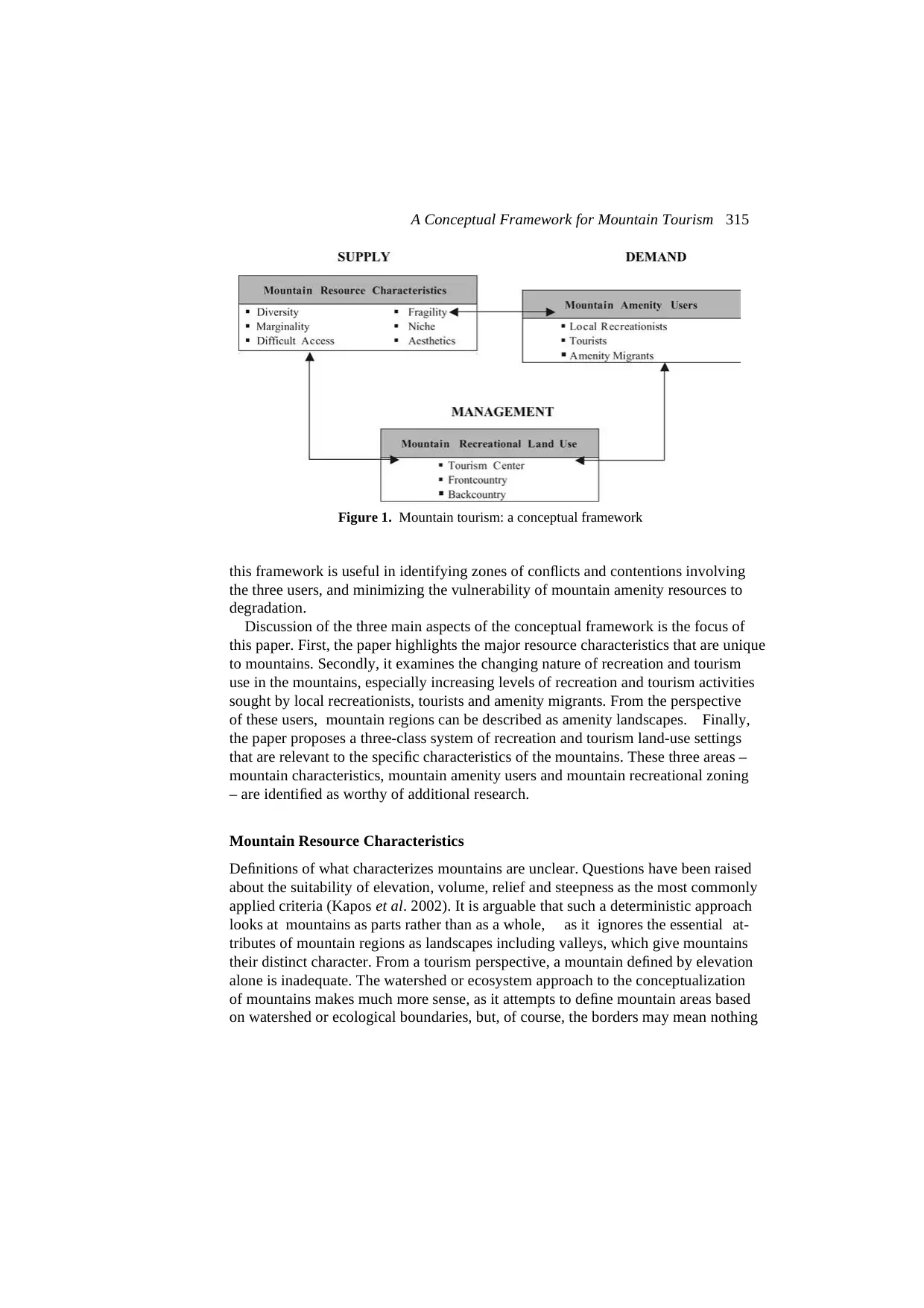
A Conceptual Framework for Mountain Tourism 315
Figure 1. Mountain tourism: a conceptual framework
this framework is useful in identifying zones of conflicts and contentions involving
the three users, and minimizing the vulnerability of mountain amenity resources to
degradation.
Discussion of the three main aspects of the conceptual framework is the focus of
this paper. First, the paper highlights the major resource characteristics that are unique
to mountains. Secondly, it examines the changing nature of recreation and tourism
use in the mountains, especially increasing levels of recreation and tourism activities
sought by local recreationists, tourists and amenity migrants. From the perspective
of these users, mountain regions can be described as amenity landscapes. Finally,
the paper proposes a three-class system of recreation and tourism land-use settings
that are relevant to the specific characteristics of the mountains. These three areas –
mountain characteristics, mountain amenity users and mountain recreational zoning
– are identified as worthy of additional research.
Mountain Resource Characteristics
Definitions of what characterizes mountains are unclear. Questions have been raised
about the suitability of elevation, volume, relief and steepness as the most commonly
applied criteria (Kapos et al. 2002). It is arguable that such a deterministic approach
looks at mountains as parts rather than as a whole, as it ignores the essential at-
tributes of mountain regions as landscapes including valleys, which give mountains
their distinct character. From a tourism perspective, a mountain defined by elevation
alone is inadequate. The watershed or ecosystem approach to the conceptualization
of mountains makes much more sense, as it attempts to define mountain areas based
on watershed or ecological boundaries, but, of course, the borders may mean nothing
Figure 1. Mountain tourism: a conceptual framework
this framework is useful in identifying zones of conflicts and contentions involving
the three users, and minimizing the vulnerability of mountain amenity resources to
degradation.
Discussion of the three main aspects of the conceptual framework is the focus of
this paper. First, the paper highlights the major resource characteristics that are unique
to mountains. Secondly, it examines the changing nature of recreation and tourism
use in the mountains, especially increasing levels of recreation and tourism activities
sought by local recreationists, tourists and amenity migrants. From the perspective
of these users, mountain regions can be described as amenity landscapes. Finally,
the paper proposes a three-class system of recreation and tourism land-use settings
that are relevant to the specific characteristics of the mountains. These three areas –
mountain characteristics, mountain amenity users and mountain recreational zoning
– are identified as worthy of additional research.
Mountain Resource Characteristics
Definitions of what characterizes mountains are unclear. Questions have been raised
about the suitability of elevation, volume, relief and steepness as the most commonly
applied criteria (Kapos et al. 2002). It is arguable that such a deterministic approach
looks at mountains as parts rather than as a whole, as it ignores the essential at-
tributes of mountain regions as landscapes including valleys, which give mountains
their distinct character. From a tourism perspective, a mountain defined by elevation
alone is inadequate. The watershed or ecosystem approach to the conceptualization
of mountains makes much more sense, as it attempts to define mountain areas based
on watershed or ecological boundaries, but, of course, the borders may mean nothing
Paraphrase This Document
Need a fresh take? Get an instant paraphrase of this document with our AI Paraphraser
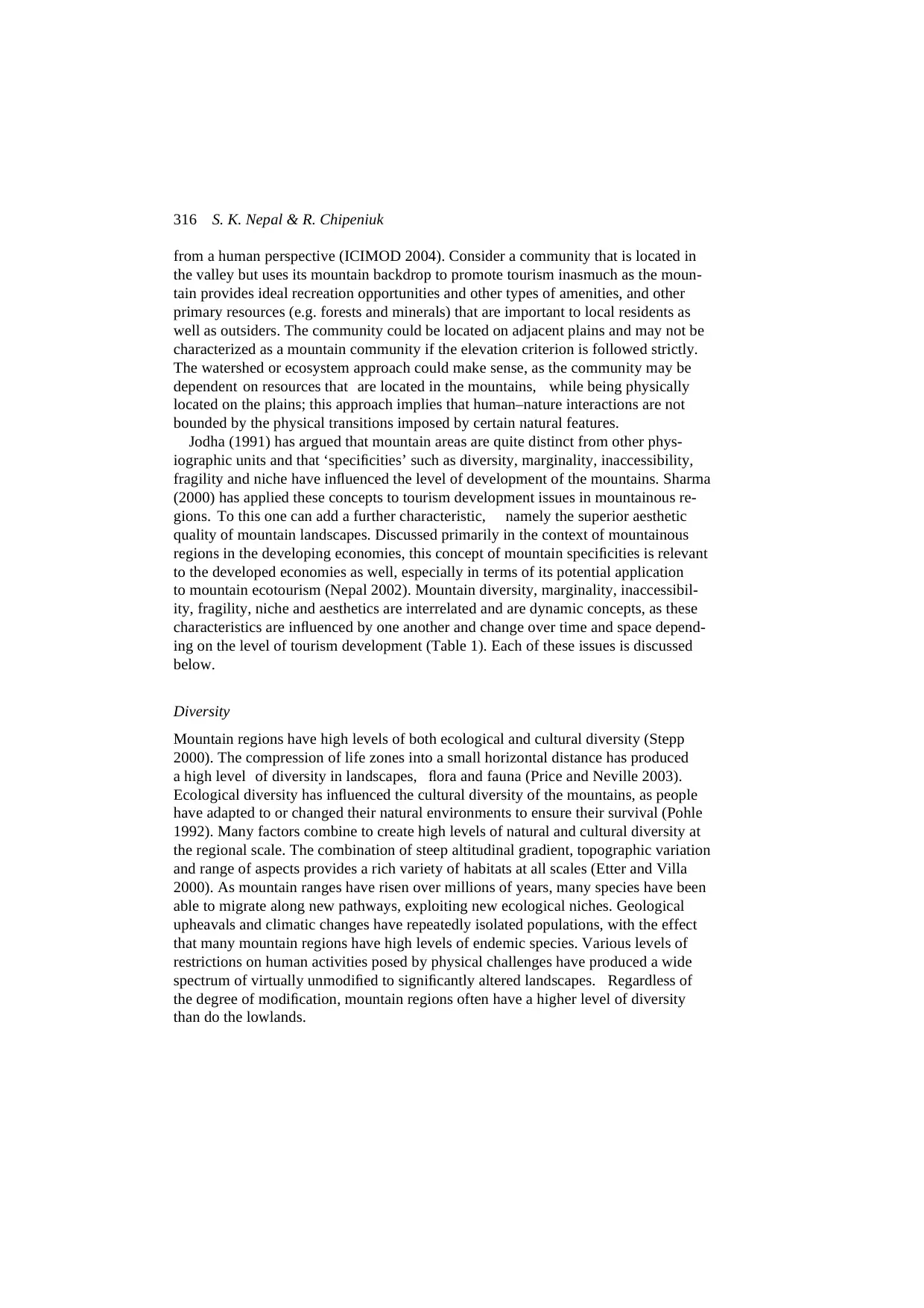
316 S. K. Nepal & R. Chipeniuk
from a human perspective (ICIMOD 2004). Consider a community that is located in
the valley but uses its mountain backdrop to promote tourism inasmuch as the moun-
tain provides ideal recreation opportunities and other types of amenities, and other
primary resources (e.g. forests and minerals) that are important to local residents as
well as outsiders. The community could be located on adjacent plains and may not be
characterized as a mountain community if the elevation criterion is followed strictly.
The watershed or ecosystem approach could make sense, as the community may be
dependent on resources that are located in the mountains, while being physically
located on the plains; this approach implies that human–nature interactions are not
bounded by the physical transitions imposed by certain natural features.
Jodha (1991) has argued that mountain areas are quite distinct from other phys-
iographic units and that ‘specificities’ such as diversity, marginality, inaccessibility,
fragility and niche have influenced the level of development of the mountains. Sharma
(2000) has applied these concepts to tourism development issues in mountainous re-
gions. To this one can add a further characteristic, namely the superior aesthetic
quality of mountain landscapes. Discussed primarily in the context of mountainous
regions in the developing economies, this concept of mountain specificities is relevant
to the developed economies as well, especially in terms of its potential application
to mountain ecotourism (Nepal 2002). Mountain diversity, marginality, inaccessibil-
ity, fragility, niche and aesthetics are interrelated and are dynamic concepts, as these
characteristics are influenced by one another and change over time and space depend-
ing on the level of tourism development (Table 1). Each of these issues is discussed
below.
Diversity
Mountain regions have high levels of both ecological and cultural diversity (Stepp
2000). The compression of life zones into a small horizontal distance has produced
a high level of diversity in landscapes, flora and fauna (Price and Neville 2003).
Ecological diversity has influenced the cultural diversity of the mountains, as people
have adapted to or changed their natural environments to ensure their survival (Pohle
1992). Many factors combine to create high levels of natural and cultural diversity at
the regional scale. The combination of steep altitudinal gradient, topographic variation
and range of aspects provides a rich variety of habitats at all scales (Etter and Villa
2000). As mountain ranges have risen over millions of years, many species have been
able to migrate along new pathways, exploiting new ecological niches. Geological
upheavals and climatic changes have repeatedly isolated populations, with the effect
that many mountain regions have high levels of endemic species. Various levels of
restrictions on human activities posed by physical challenges have produced a wide
spectrum of virtually unmodified to significantly altered landscapes. Regardless of
the degree of modification, mountain regions often have a higher level of diversity
than do the lowlands.
from a human perspective (ICIMOD 2004). Consider a community that is located in
the valley but uses its mountain backdrop to promote tourism inasmuch as the moun-
tain provides ideal recreation opportunities and other types of amenities, and other
primary resources (e.g. forests and minerals) that are important to local residents as
well as outsiders. The community could be located on adjacent plains and may not be
characterized as a mountain community if the elevation criterion is followed strictly.
The watershed or ecosystem approach could make sense, as the community may be
dependent on resources that are located in the mountains, while being physically
located on the plains; this approach implies that human–nature interactions are not
bounded by the physical transitions imposed by certain natural features.
Jodha (1991) has argued that mountain areas are quite distinct from other phys-
iographic units and that ‘specificities’ such as diversity, marginality, inaccessibility,
fragility and niche have influenced the level of development of the mountains. Sharma
(2000) has applied these concepts to tourism development issues in mountainous re-
gions. To this one can add a further characteristic, namely the superior aesthetic
quality of mountain landscapes. Discussed primarily in the context of mountainous
regions in the developing economies, this concept of mountain specificities is relevant
to the developed economies as well, especially in terms of its potential application
to mountain ecotourism (Nepal 2002). Mountain diversity, marginality, inaccessibil-
ity, fragility, niche and aesthetics are interrelated and are dynamic concepts, as these
characteristics are influenced by one another and change over time and space depend-
ing on the level of tourism development (Table 1). Each of these issues is discussed
below.
Diversity
Mountain regions have high levels of both ecological and cultural diversity (Stepp
2000). The compression of life zones into a small horizontal distance has produced
a high level of diversity in landscapes, flora and fauna (Price and Neville 2003).
Ecological diversity has influenced the cultural diversity of the mountains, as people
have adapted to or changed their natural environments to ensure their survival (Pohle
1992). Many factors combine to create high levels of natural and cultural diversity at
the regional scale. The combination of steep altitudinal gradient, topographic variation
and range of aspects provides a rich variety of habitats at all scales (Etter and Villa
2000). As mountain ranges have risen over millions of years, many species have been
able to migrate along new pathways, exploiting new ecological niches. Geological
upheavals and climatic changes have repeatedly isolated populations, with the effect
that many mountain regions have high levels of endemic species. Various levels of
restrictions on human activities posed by physical challenges have produced a wide
spectrum of virtually unmodified to significantly altered landscapes. Regardless of
the degree of modification, mountain regions often have a higher level of diversity
than do the lowlands.
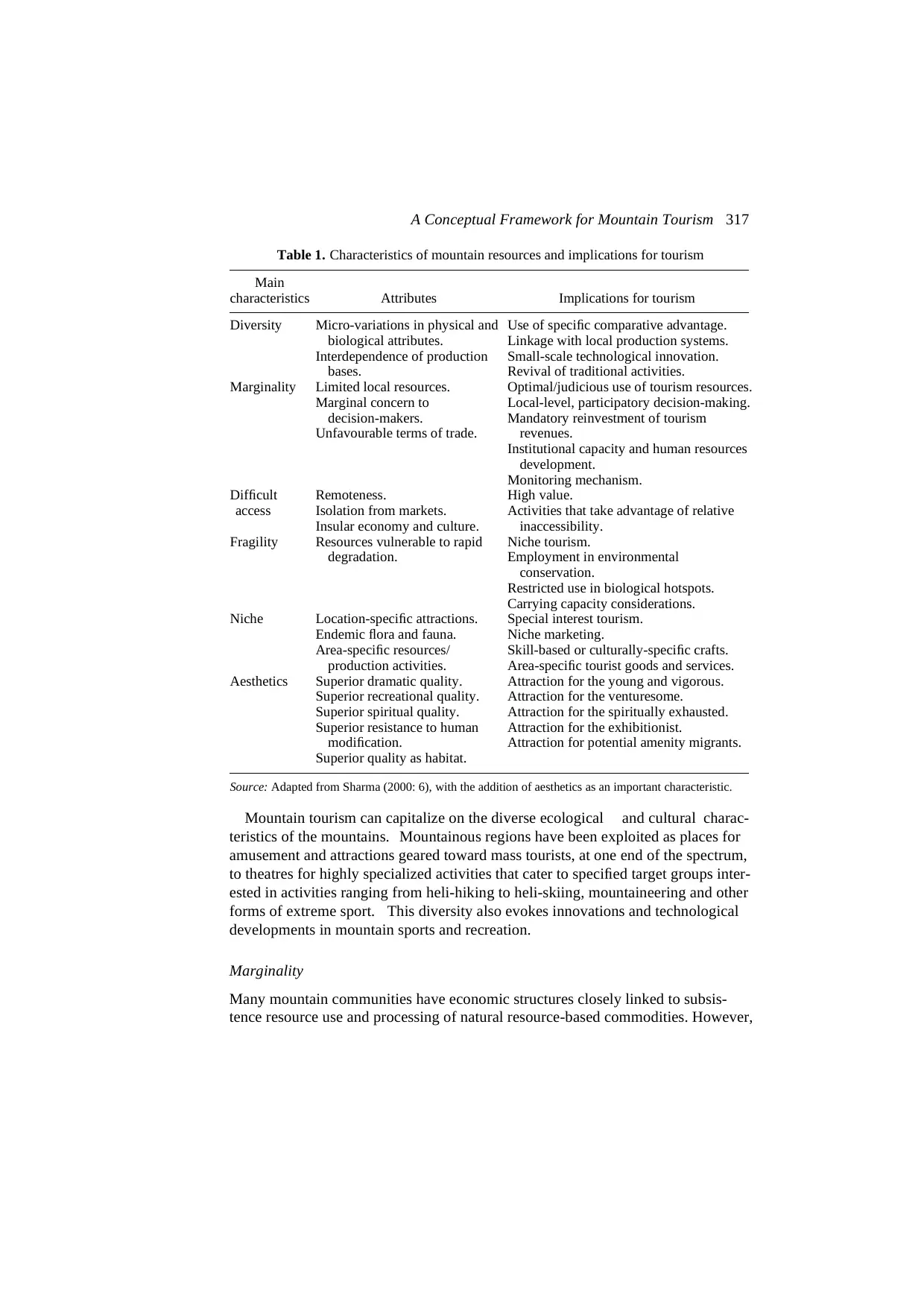
A Conceptual Framework for Mountain Tourism 317
Table 1. Characteristics of mountain resources and implications for tourism
Main
characteristics Attributes Implications for tourism
Diversity Micro-variations in physical and
biological attributes.
Interdependence of production
bases.
Use of specific comparative advantage.
Linkage with local production systems.
Small-scale technological innovation.
Revival of traditional activities.
Marginality Limited local resources.
Marginal concern to
decision-makers.
Unfavourable terms of trade.
Optimal/judicious use of tourism resources.
Local-level, participatory decision-making.
Mandatory reinvestment of tourism
revenues.
Institutional capacity and human resources
development.
Monitoring mechanism.
Difficult
access
Remoteness.
Isolation from markets.
Insular economy and culture.
High value.
Activities that take advantage of relative
inaccessibility.
Fragility Resources vulnerable to rapid
degradation.
Niche tourism.
Employment in environmental
conservation.
Restricted use in biological hotspots.
Carrying capacity considerations.
Niche Location-specific attractions.
Endemic flora and fauna.
Area-specific resources/
production activities.
Special interest tourism.
Niche marketing.
Skill-based or culturally-specific crafts.
Area-specific tourist goods and services.
Aesthetics Superior dramatic quality.
Superior recreational quality.
Superior spiritual quality.
Superior resistance to human
modification.
Superior quality as habitat.
Attraction for the young and vigorous.
Attraction for the venturesome.
Attraction for the spiritually exhausted.
Attraction for the exhibitionist.
Attraction for potential amenity migrants.
Source: Adapted from Sharma (2000: 6), with the addition of aesthetics as an important characteristic.
Mountain tourism can capitalize on the diverse ecological and cultural charac-
teristics of the mountains. Mountainous regions have been exploited as places for
amusement and attractions geared toward mass tourists, at one end of the spectrum,
to theatres for highly specialized activities that cater to specified target groups inter-
ested in activities ranging from heli-hiking to heli-skiing, mountaineering and other
forms of extreme sport. This diversity also evokes innovations and technological
developments in mountain sports and recreation.
Marginality
Many mountain communities have economic structures closely linked to subsis-
tence resource use and processing of natural resource-based commodities. However,
Table 1. Characteristics of mountain resources and implications for tourism
Main
characteristics Attributes Implications for tourism
Diversity Micro-variations in physical and
biological attributes.
Interdependence of production
bases.
Use of specific comparative advantage.
Linkage with local production systems.
Small-scale technological innovation.
Revival of traditional activities.
Marginality Limited local resources.
Marginal concern to
decision-makers.
Unfavourable terms of trade.
Optimal/judicious use of tourism resources.
Local-level, participatory decision-making.
Mandatory reinvestment of tourism
revenues.
Institutional capacity and human resources
development.
Monitoring mechanism.
Difficult
access
Remoteness.
Isolation from markets.
Insular economy and culture.
High value.
Activities that take advantage of relative
inaccessibility.
Fragility Resources vulnerable to rapid
degradation.
Niche tourism.
Employment in environmental
conservation.
Restricted use in biological hotspots.
Carrying capacity considerations.
Niche Location-specific attractions.
Endemic flora and fauna.
Area-specific resources/
production activities.
Special interest tourism.
Niche marketing.
Skill-based or culturally-specific crafts.
Area-specific tourist goods and services.
Aesthetics Superior dramatic quality.
Superior recreational quality.
Superior spiritual quality.
Superior resistance to human
modification.
Superior quality as habitat.
Attraction for the young and vigorous.
Attraction for the venturesome.
Attraction for the spiritually exhausted.
Attraction for the exhibitionist.
Attraction for potential amenity migrants.
Source: Adapted from Sharma (2000: 6), with the addition of aesthetics as an important characteristic.
Mountain tourism can capitalize on the diverse ecological and cultural charac-
teristics of the mountains. Mountainous regions have been exploited as places for
amusement and attractions geared toward mass tourists, at one end of the spectrum,
to theatres for highly specialized activities that cater to specified target groups inter-
ested in activities ranging from heli-hiking to heli-skiing, mountaineering and other
forms of extreme sport. This diversity also evokes innovations and technological
developments in mountain sports and recreation.
Marginality
Many mountain communities have economic structures closely linked to subsis-
tence resource use and processing of natural resource-based commodities. However,
⊘ This is a preview!⊘
Do you want full access?
Subscribe today to unlock all pages.

Trusted by 1+ million students worldwide
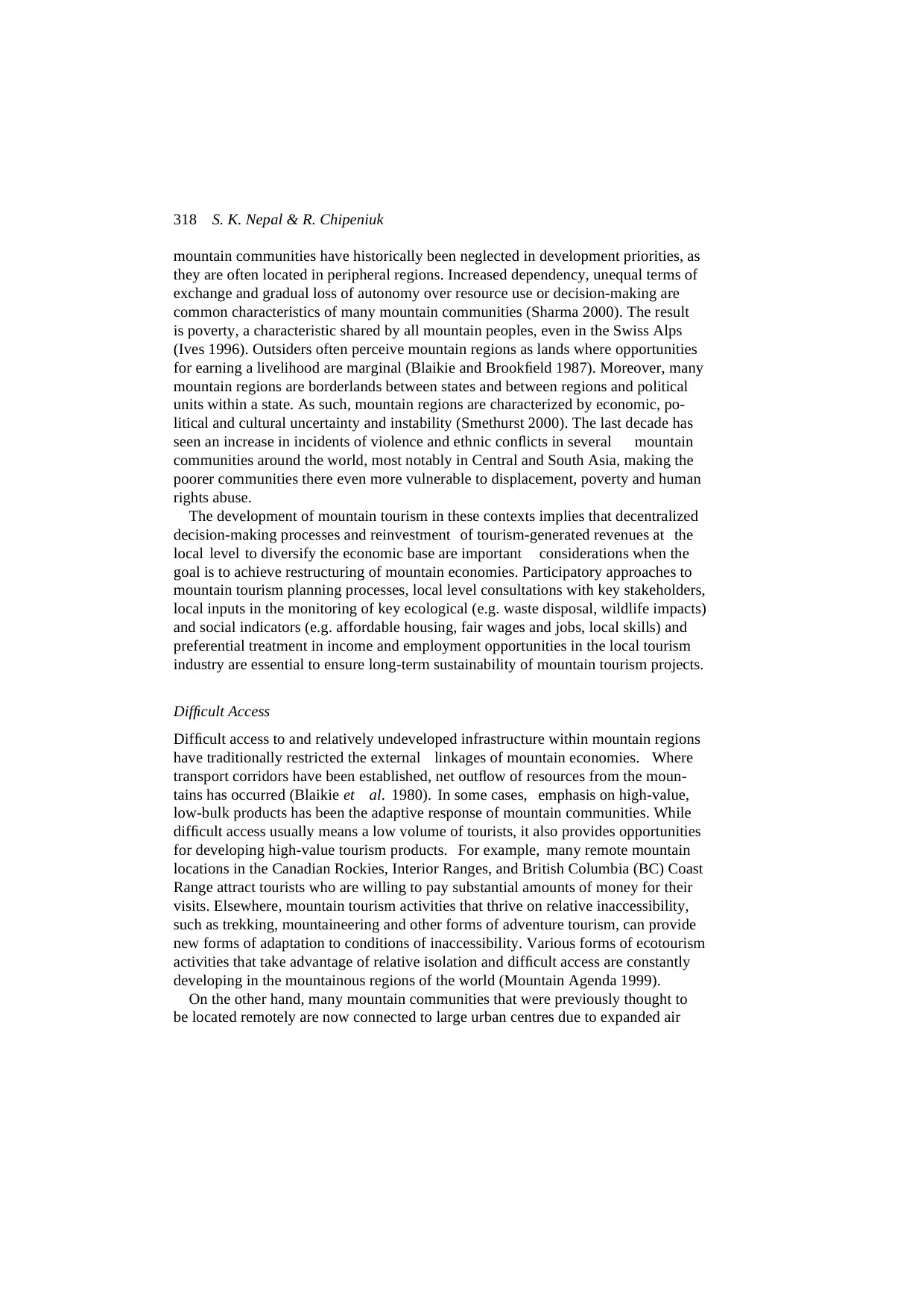
318 S. K. Nepal & R. Chipeniuk
mountain communities have historically been neglected in development priorities, as
they are often located in peripheral regions. Increased dependency, unequal terms of
exchange and gradual loss of autonomy over resource use or decision-making are
common characteristics of many mountain communities (Sharma 2000). The result
is poverty, a characteristic shared by all mountain peoples, even in the Swiss Alps
(Ives 1996). Outsiders often perceive mountain regions as lands where opportunities
for earning a livelihood are marginal (Blaikie and Brookfield 1987). Moreover, many
mountain regions are borderlands between states and between regions and political
units within a state. As such, mountain regions are characterized by economic, po-
litical and cultural uncertainty and instability (Smethurst 2000). The last decade has
seen an increase in incidents of violence and ethnic conflicts in several mountain
communities around the world, most notably in Central and South Asia, making the
poorer communities there even more vulnerable to displacement, poverty and human
rights abuse.
The development of mountain tourism in these contexts implies that decentralized
decision-making processes and reinvestment of tourism-generated revenues at the
local level to diversify the economic base are important considerations when the
goal is to achieve restructuring of mountain economies. Participatory approaches to
mountain tourism planning processes, local level consultations with key stakeholders,
local inputs in the monitoring of key ecological (e.g. waste disposal, wildlife impacts)
and social indicators (e.g. affordable housing, fair wages and jobs, local skills) and
preferential treatment in income and employment opportunities in the local tourism
industry are essential to ensure long-term sustainability of mountain tourism projects.
Difficult Access
Difficult access to and relatively undeveloped infrastructure within mountain regions
have traditionally restricted the external linkages of mountain economies. Where
transport corridors have been established, net outflow of resources from the moun-
tains has occurred (Blaikie et al. 1980). In some cases, emphasis on high-value,
low-bulk products has been the adaptive response of mountain communities. While
difficult access usually means a low volume of tourists, it also provides opportunities
for developing high-value tourism products. For example, many remote mountain
locations in the Canadian Rockies, Interior Ranges, and British Columbia (BC) Coast
Range attract tourists who are willing to pay substantial amounts of money for their
visits. Elsewhere, mountain tourism activities that thrive on relative inaccessibility,
such as trekking, mountaineering and other forms of adventure tourism, can provide
new forms of adaptation to conditions of inaccessibility. Various forms of ecotourism
activities that take advantage of relative isolation and difficult access are constantly
developing in the mountainous regions of the world (Mountain Agenda 1999).
On the other hand, many mountain communities that were previously thought to
be located remotely are now connected to large urban centres due to expanded air
mountain communities have historically been neglected in development priorities, as
they are often located in peripheral regions. Increased dependency, unequal terms of
exchange and gradual loss of autonomy over resource use or decision-making are
common characteristics of many mountain communities (Sharma 2000). The result
is poverty, a characteristic shared by all mountain peoples, even in the Swiss Alps
(Ives 1996). Outsiders often perceive mountain regions as lands where opportunities
for earning a livelihood are marginal (Blaikie and Brookfield 1987). Moreover, many
mountain regions are borderlands between states and between regions and political
units within a state. As such, mountain regions are characterized by economic, po-
litical and cultural uncertainty and instability (Smethurst 2000). The last decade has
seen an increase in incidents of violence and ethnic conflicts in several mountain
communities around the world, most notably in Central and South Asia, making the
poorer communities there even more vulnerable to displacement, poverty and human
rights abuse.
The development of mountain tourism in these contexts implies that decentralized
decision-making processes and reinvestment of tourism-generated revenues at the
local level to diversify the economic base are important considerations when the
goal is to achieve restructuring of mountain economies. Participatory approaches to
mountain tourism planning processes, local level consultations with key stakeholders,
local inputs in the monitoring of key ecological (e.g. waste disposal, wildlife impacts)
and social indicators (e.g. affordable housing, fair wages and jobs, local skills) and
preferential treatment in income and employment opportunities in the local tourism
industry are essential to ensure long-term sustainability of mountain tourism projects.
Difficult Access
Difficult access to and relatively undeveloped infrastructure within mountain regions
have traditionally restricted the external linkages of mountain economies. Where
transport corridors have been established, net outflow of resources from the moun-
tains has occurred (Blaikie et al. 1980). In some cases, emphasis on high-value,
low-bulk products has been the adaptive response of mountain communities. While
difficult access usually means a low volume of tourists, it also provides opportunities
for developing high-value tourism products. For example, many remote mountain
locations in the Canadian Rockies, Interior Ranges, and British Columbia (BC) Coast
Range attract tourists who are willing to pay substantial amounts of money for their
visits. Elsewhere, mountain tourism activities that thrive on relative inaccessibility,
such as trekking, mountaineering and other forms of adventure tourism, can provide
new forms of adaptation to conditions of inaccessibility. Various forms of ecotourism
activities that take advantage of relative isolation and difficult access are constantly
developing in the mountainous regions of the world (Mountain Agenda 1999).
On the other hand, many mountain communities that were previously thought to
be located remotely are now connected to large urban centres due to expanded air
Paraphrase This Document
Need a fresh take? Get an instant paraphrase of this document with our AI Paraphraser
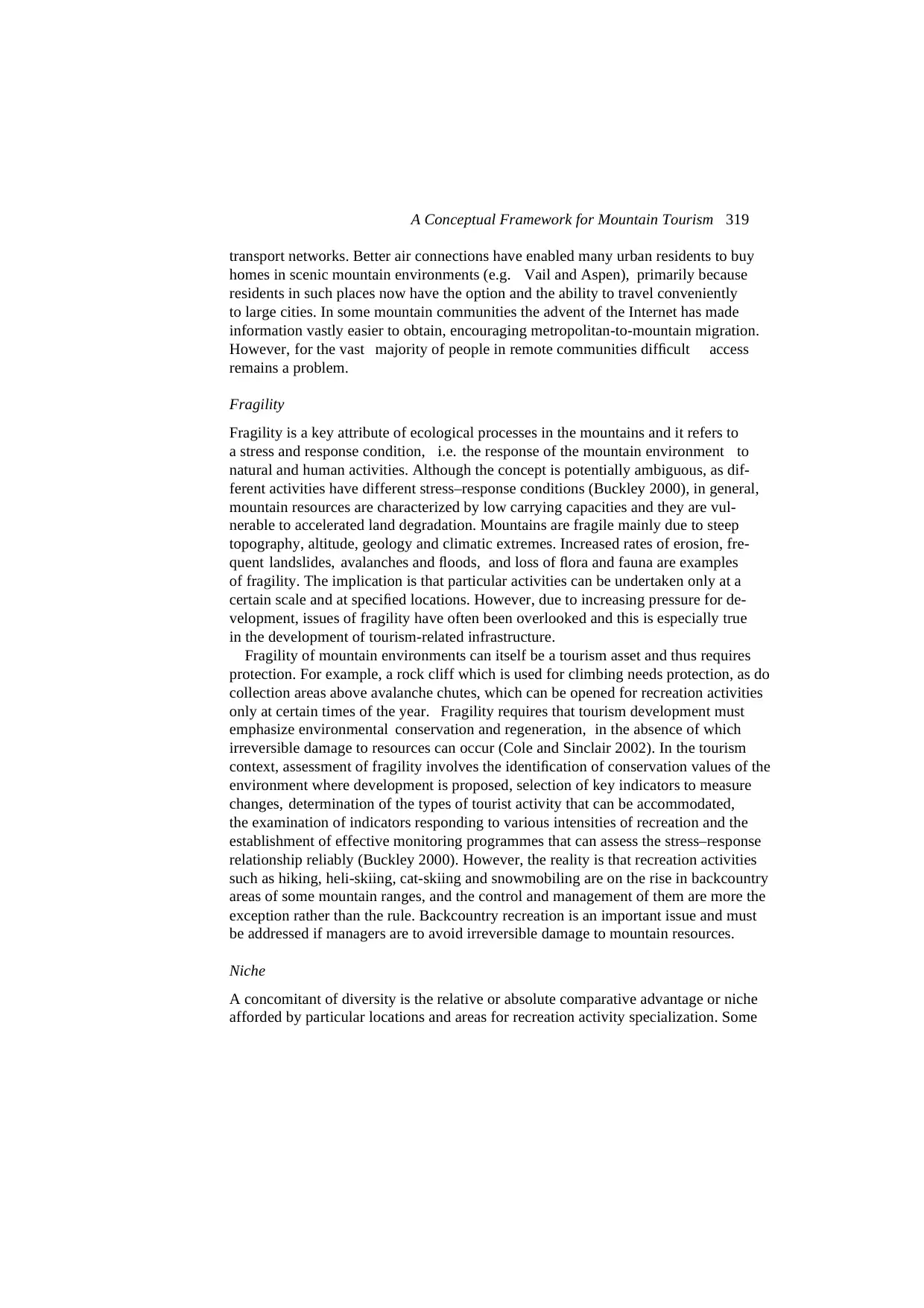
A Conceptual Framework for Mountain Tourism 319
transport networks. Better air connections have enabled many urban residents to buy
homes in scenic mountain environments (e.g. Vail and Aspen), primarily because
residents in such places now have the option and the ability to travel conveniently
to large cities. In some mountain communities the advent of the Internet has made
information vastly easier to obtain, encouraging metropolitan-to-mountain migration.
However, for the vast majority of people in remote communities difficult access
remains a problem.
Fragility
Fragility is a key attribute of ecological processes in the mountains and it refers to
a stress and response condition, i.e. the response of the mountain environment to
natural and human activities. Although the concept is potentially ambiguous, as dif-
ferent activities have different stress–response conditions (Buckley 2000), in general,
mountain resources are characterized by low carrying capacities and they are vul-
nerable to accelerated land degradation. Mountains are fragile mainly due to steep
topography, altitude, geology and climatic extremes. Increased rates of erosion, fre-
quent landslides, avalanches and floods, and loss of flora and fauna are examples
of fragility. The implication is that particular activities can be undertaken only at a
certain scale and at specified locations. However, due to increasing pressure for de-
velopment, issues of fragility have often been overlooked and this is especially true
in the development of tourism-related infrastructure.
Fragility of mountain environments can itself be a tourism asset and thus requires
protection. For example, a rock cliff which is used for climbing needs protection, as do
collection areas above avalanche chutes, which can be opened for recreation activities
only at certain times of the year. Fragility requires that tourism development must
emphasize environmental conservation and regeneration, in the absence of which
irreversible damage to resources can occur (Cole and Sinclair 2002). In the tourism
context, assessment of fragility involves the identification of conservation values of the
environment where development is proposed, selection of key indicators to measure
changes, determination of the types of tourist activity that can be accommodated,
the examination of indicators responding to various intensities of recreation and the
establishment of effective monitoring programmes that can assess the stress–response
relationship reliably (Buckley 2000). However, the reality is that recreation activities
such as hiking, heli-skiing, cat-skiing and snowmobiling are on the rise in backcountry
areas of some mountain ranges, and the control and management of them are more the
exception rather than the rule. Backcountry recreation is an important issue and must
be addressed if managers are to avoid irreversible damage to mountain resources.
Niche
A concomitant of diversity is the relative or absolute comparative advantage or niche
afforded by particular locations and areas for recreation activity specialization. Some
transport networks. Better air connections have enabled many urban residents to buy
homes in scenic mountain environments (e.g. Vail and Aspen), primarily because
residents in such places now have the option and the ability to travel conveniently
to large cities. In some mountain communities the advent of the Internet has made
information vastly easier to obtain, encouraging metropolitan-to-mountain migration.
However, for the vast majority of people in remote communities difficult access
remains a problem.
Fragility
Fragility is a key attribute of ecological processes in the mountains and it refers to
a stress and response condition, i.e. the response of the mountain environment to
natural and human activities. Although the concept is potentially ambiguous, as dif-
ferent activities have different stress–response conditions (Buckley 2000), in general,
mountain resources are characterized by low carrying capacities and they are vul-
nerable to accelerated land degradation. Mountains are fragile mainly due to steep
topography, altitude, geology and climatic extremes. Increased rates of erosion, fre-
quent landslides, avalanches and floods, and loss of flora and fauna are examples
of fragility. The implication is that particular activities can be undertaken only at a
certain scale and at specified locations. However, due to increasing pressure for de-
velopment, issues of fragility have often been overlooked and this is especially true
in the development of tourism-related infrastructure.
Fragility of mountain environments can itself be a tourism asset and thus requires
protection. For example, a rock cliff which is used for climbing needs protection, as do
collection areas above avalanche chutes, which can be opened for recreation activities
only at certain times of the year. Fragility requires that tourism development must
emphasize environmental conservation and regeneration, in the absence of which
irreversible damage to resources can occur (Cole and Sinclair 2002). In the tourism
context, assessment of fragility involves the identification of conservation values of the
environment where development is proposed, selection of key indicators to measure
changes, determination of the types of tourist activity that can be accommodated,
the examination of indicators responding to various intensities of recreation and the
establishment of effective monitoring programmes that can assess the stress–response
relationship reliably (Buckley 2000). However, the reality is that recreation activities
such as hiking, heli-skiing, cat-skiing and snowmobiling are on the rise in backcountry
areas of some mountain ranges, and the control and management of them are more the
exception rather than the rule. Backcountry recreation is an important issue and must
be addressed if managers are to avoid irreversible damage to mountain resources.
Niche
A concomitant of diversity is the relative or absolute comparative advantage or niche
afforded by particular locations and areas for recreation activity specialization. Some
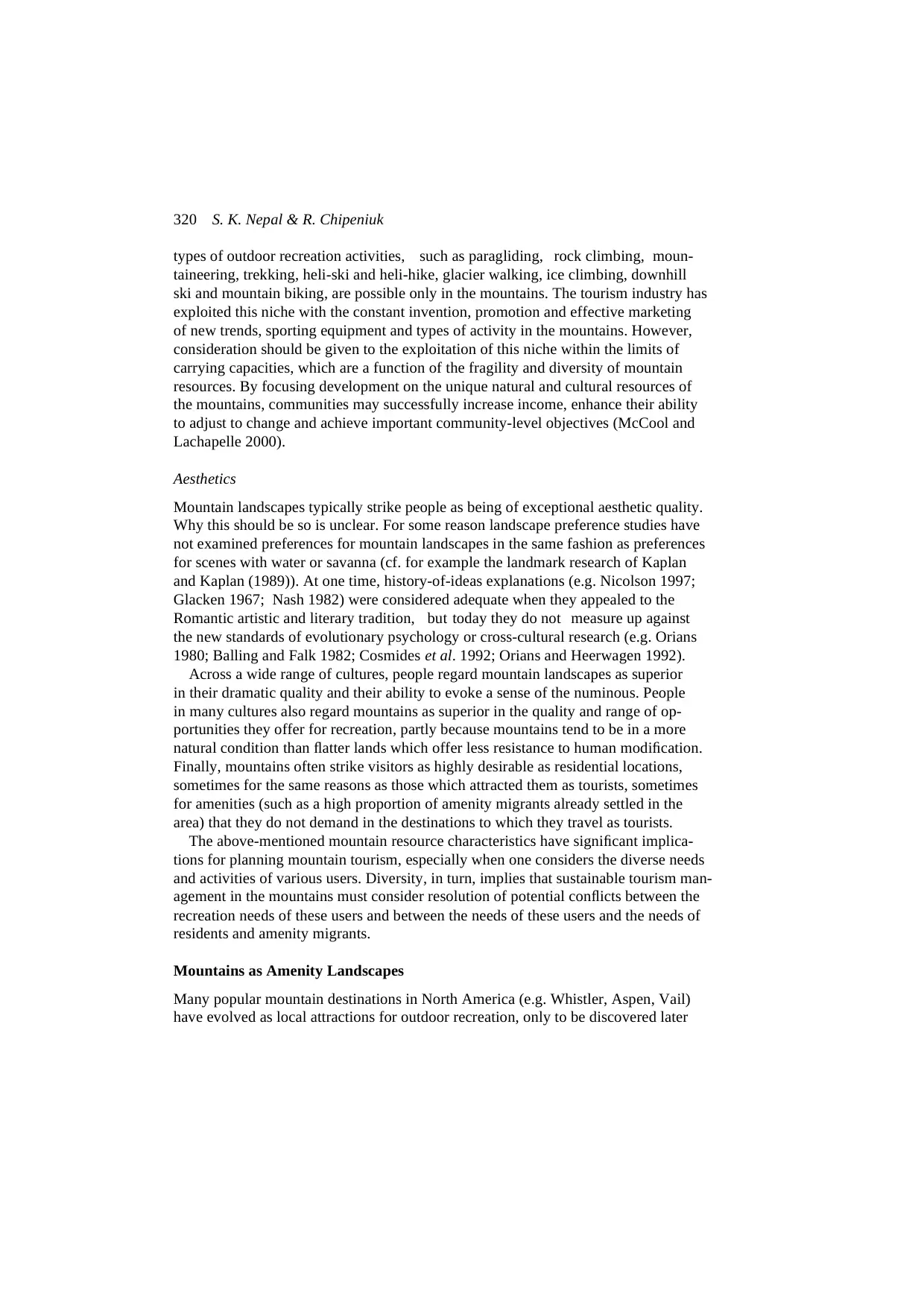
320 S. K. Nepal & R. Chipeniuk
types of outdoor recreation activities, such as paragliding, rock climbing, moun-
taineering, trekking, heli-ski and heli-hike, glacier walking, ice climbing, downhill
ski and mountain biking, are possible only in the mountains. The tourism industry has
exploited this niche with the constant invention, promotion and effective marketing
of new trends, sporting equipment and types of activity in the mountains. However,
consideration should be given to the exploitation of this niche within the limits of
carrying capacities, which are a function of the fragility and diversity of mountain
resources. By focusing development on the unique natural and cultural resources of
the mountains, communities may successfully increase income, enhance their ability
to adjust to change and achieve important community-level objectives (McCool and
Lachapelle 2000).
Aesthetics
Mountain landscapes typically strike people as being of exceptional aesthetic quality.
Why this should be so is unclear. For some reason landscape preference studies have
not examined preferences for mountain landscapes in the same fashion as preferences
for scenes with water or savanna (cf. for example the landmark research of Kaplan
and Kaplan (1989)). At one time, history-of-ideas explanations (e.g. Nicolson 1997;
Glacken 1967; Nash 1982) were considered adequate when they appealed to the
Romantic artistic and literary tradition, but today they do not measure up against
the new standards of evolutionary psychology or cross-cultural research (e.g. Orians
1980; Balling and Falk 1982; Cosmides et al. 1992; Orians and Heerwagen 1992).
Across a wide range of cultures, people regard mountain landscapes as superior
in their dramatic quality and their ability to evoke a sense of the numinous. People
in many cultures also regard mountains as superior in the quality and range of op-
portunities they offer for recreation, partly because mountains tend to be in a more
natural condition than flatter lands which offer less resistance to human modification.
Finally, mountains often strike visitors as highly desirable as residential locations,
sometimes for the same reasons as those which attracted them as tourists, sometimes
for amenities (such as a high proportion of amenity migrants already settled in the
area) that they do not demand in the destinations to which they travel as tourists.
The above-mentioned mountain resource characteristics have significant implica-
tions for planning mountain tourism, especially when one considers the diverse needs
and activities of various users. Diversity, in turn, implies that sustainable tourism man-
agement in the mountains must consider resolution of potential conflicts between the
recreation needs of these users and between the needs of these users and the needs of
residents and amenity migrants.
Mountains as Amenity Landscapes
Many popular mountain destinations in North America (e.g. Whistler, Aspen, Vail)
have evolved as local attractions for outdoor recreation, only to be discovered later
types of outdoor recreation activities, such as paragliding, rock climbing, moun-
taineering, trekking, heli-ski and heli-hike, glacier walking, ice climbing, downhill
ski and mountain biking, are possible only in the mountains. The tourism industry has
exploited this niche with the constant invention, promotion and effective marketing
of new trends, sporting equipment and types of activity in the mountains. However,
consideration should be given to the exploitation of this niche within the limits of
carrying capacities, which are a function of the fragility and diversity of mountain
resources. By focusing development on the unique natural and cultural resources of
the mountains, communities may successfully increase income, enhance their ability
to adjust to change and achieve important community-level objectives (McCool and
Lachapelle 2000).
Aesthetics
Mountain landscapes typically strike people as being of exceptional aesthetic quality.
Why this should be so is unclear. For some reason landscape preference studies have
not examined preferences for mountain landscapes in the same fashion as preferences
for scenes with water or savanna (cf. for example the landmark research of Kaplan
and Kaplan (1989)). At one time, history-of-ideas explanations (e.g. Nicolson 1997;
Glacken 1967; Nash 1982) were considered adequate when they appealed to the
Romantic artistic and literary tradition, but today they do not measure up against
the new standards of evolutionary psychology or cross-cultural research (e.g. Orians
1980; Balling and Falk 1982; Cosmides et al. 1992; Orians and Heerwagen 1992).
Across a wide range of cultures, people regard mountain landscapes as superior
in their dramatic quality and their ability to evoke a sense of the numinous. People
in many cultures also regard mountains as superior in the quality and range of op-
portunities they offer for recreation, partly because mountains tend to be in a more
natural condition than flatter lands which offer less resistance to human modification.
Finally, mountains often strike visitors as highly desirable as residential locations,
sometimes for the same reasons as those which attracted them as tourists, sometimes
for amenities (such as a high proportion of amenity migrants already settled in the
area) that they do not demand in the destinations to which they travel as tourists.
The above-mentioned mountain resource characteristics have significant implica-
tions for planning mountain tourism, especially when one considers the diverse needs
and activities of various users. Diversity, in turn, implies that sustainable tourism man-
agement in the mountains must consider resolution of potential conflicts between the
recreation needs of these users and between the needs of these users and the needs of
residents and amenity migrants.
Mountains as Amenity Landscapes
Many popular mountain destinations in North America (e.g. Whistler, Aspen, Vail)
have evolved as local attractions for outdoor recreation, only to be discovered later
⊘ This is a preview!⊘
Do you want full access?
Subscribe today to unlock all pages.

Trusted by 1+ million students worldwide
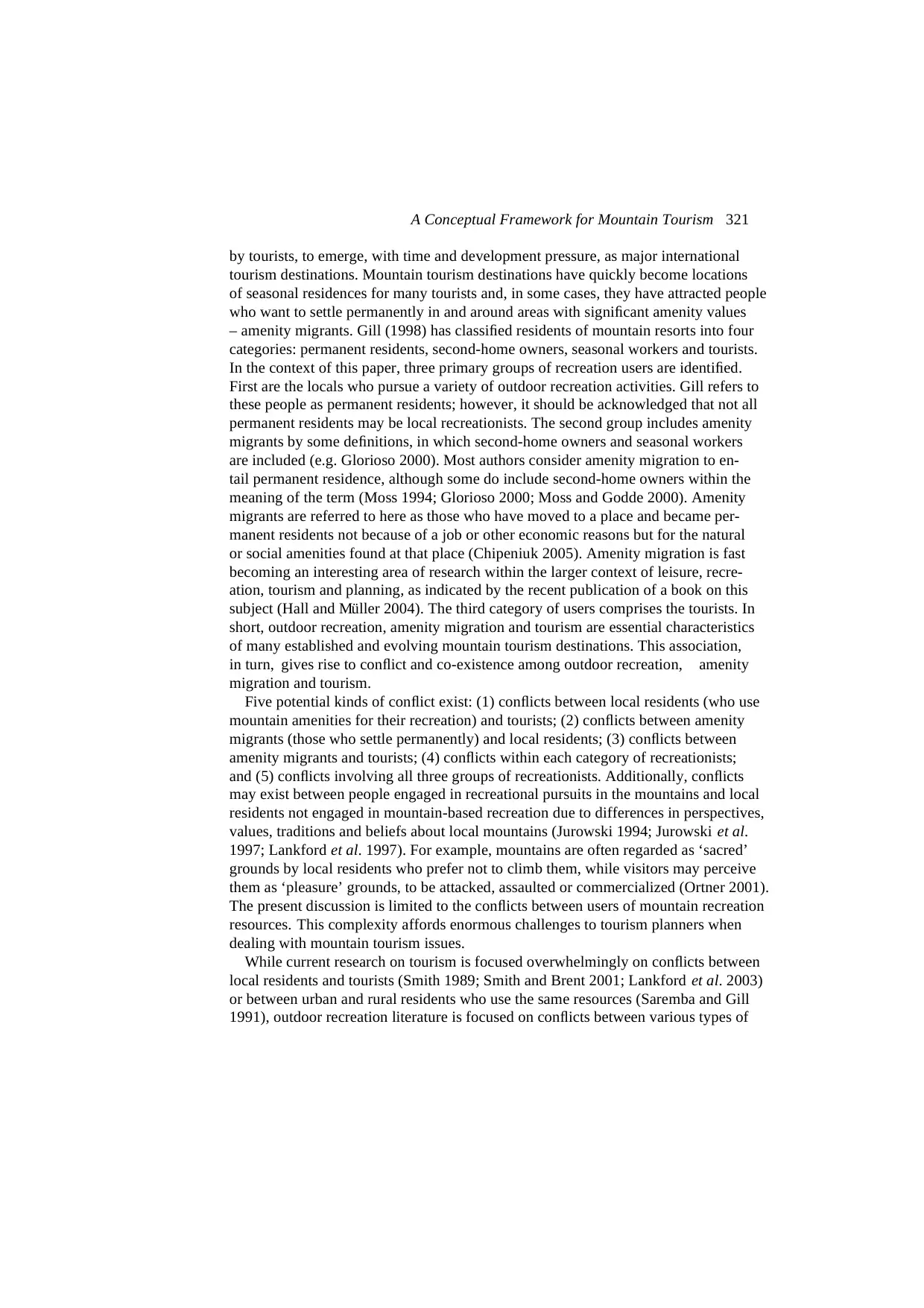
A Conceptual Framework for Mountain Tourism 321
by tourists, to emerge, with time and development pressure, as major international
tourism destinations. Mountain tourism destinations have quickly become locations
of seasonal residences for many tourists and, in some cases, they have attracted people
who want to settle permanently in and around areas with significant amenity values
– amenity migrants. Gill (1998) has classified residents of mountain resorts into four
categories: permanent residents, second-home owners, seasonal workers and tourists.
In the context of this paper, three primary groups of recreation users are identified.
First are the locals who pursue a variety of outdoor recreation activities. Gill refers to
these people as permanent residents; however, it should be acknowledged that not all
permanent residents may be local recreationists. The second group includes amenity
migrants by some definitions, in which second-home owners and seasonal workers
are included (e.g. Glorioso 2000). Most authors consider amenity migration to en-
tail permanent residence, although some do include second-home owners within the
meaning of the term (Moss 1994; Glorioso 2000; Moss and Godde 2000). Amenity
migrants are referred to here as those who have moved to a place and became per-
manent residents not because of a job or other economic reasons but for the natural
or social amenities found at that place (Chipeniuk 2005). Amenity migration is fast
becoming an interesting area of research within the larger context of leisure, recre-
ation, tourism and planning, as indicated by the recent publication of a book on this
subject (Hall and M¨uller 2004). The third category of users comprises the tourists. In
short, outdoor recreation, amenity migration and tourism are essential characteristics
of many established and evolving mountain tourism destinations. This association,
in turn, gives rise to conflict and co-existence among outdoor recreation, amenity
migration and tourism.
Five potential kinds of conflict exist: (1) conflicts between local residents (who use
mountain amenities for their recreation) and tourists; (2) conflicts between amenity
migrants (those who settle permanently) and local residents; (3) conflicts between
amenity migrants and tourists; (4) conflicts within each category of recreationists;
and (5) conflicts involving all three groups of recreationists. Additionally, conflicts
may exist between people engaged in recreational pursuits in the mountains and local
residents not engaged in mountain-based recreation due to differences in perspectives,
values, traditions and beliefs about local mountains (Jurowski 1994; Jurowski et al.
1997; Lankford et al. 1997). For example, mountains are often regarded as ‘sacred’
grounds by local residents who prefer not to climb them, while visitors may perceive
them as ‘pleasure’ grounds, to be attacked, assaulted or commercialized (Ortner 2001).
The present discussion is limited to the conflicts between users of mountain recreation
resources. This complexity affords enormous challenges to tourism planners when
dealing with mountain tourism issues.
While current research on tourism is focused overwhelmingly on conflicts between
local residents and tourists (Smith 1989; Smith and Brent 2001; Lankford et al. 2003)
or between urban and rural residents who use the same resources (Saremba and Gill
1991), outdoor recreation literature is focused on conflicts between various types of
by tourists, to emerge, with time and development pressure, as major international
tourism destinations. Mountain tourism destinations have quickly become locations
of seasonal residences for many tourists and, in some cases, they have attracted people
who want to settle permanently in and around areas with significant amenity values
– amenity migrants. Gill (1998) has classified residents of mountain resorts into four
categories: permanent residents, second-home owners, seasonal workers and tourists.
In the context of this paper, three primary groups of recreation users are identified.
First are the locals who pursue a variety of outdoor recreation activities. Gill refers to
these people as permanent residents; however, it should be acknowledged that not all
permanent residents may be local recreationists. The second group includes amenity
migrants by some definitions, in which second-home owners and seasonal workers
are included (e.g. Glorioso 2000). Most authors consider amenity migration to en-
tail permanent residence, although some do include second-home owners within the
meaning of the term (Moss 1994; Glorioso 2000; Moss and Godde 2000). Amenity
migrants are referred to here as those who have moved to a place and became per-
manent residents not because of a job or other economic reasons but for the natural
or social amenities found at that place (Chipeniuk 2005). Amenity migration is fast
becoming an interesting area of research within the larger context of leisure, recre-
ation, tourism and planning, as indicated by the recent publication of a book on this
subject (Hall and M¨uller 2004). The third category of users comprises the tourists. In
short, outdoor recreation, amenity migration and tourism are essential characteristics
of many established and evolving mountain tourism destinations. This association,
in turn, gives rise to conflict and co-existence among outdoor recreation, amenity
migration and tourism.
Five potential kinds of conflict exist: (1) conflicts between local residents (who use
mountain amenities for their recreation) and tourists; (2) conflicts between amenity
migrants (those who settle permanently) and local residents; (3) conflicts between
amenity migrants and tourists; (4) conflicts within each category of recreationists;
and (5) conflicts involving all three groups of recreationists. Additionally, conflicts
may exist between people engaged in recreational pursuits in the mountains and local
residents not engaged in mountain-based recreation due to differences in perspectives,
values, traditions and beliefs about local mountains (Jurowski 1994; Jurowski et al.
1997; Lankford et al. 1997). For example, mountains are often regarded as ‘sacred’
grounds by local residents who prefer not to climb them, while visitors may perceive
them as ‘pleasure’ grounds, to be attacked, assaulted or commercialized (Ortner 2001).
The present discussion is limited to the conflicts between users of mountain recreation
resources. This complexity affords enormous challenges to tourism planners when
dealing with mountain tourism issues.
While current research on tourism is focused overwhelmingly on conflicts between
local residents and tourists (Smith 1989; Smith and Brent 2001; Lankford et al. 2003)
or between urban and rural residents who use the same resources (Saremba and Gill
1991), outdoor recreation literature is focused on conflicts between various types of
Paraphrase This Document
Need a fresh take? Get an instant paraphrase of this document with our AI Paraphraser
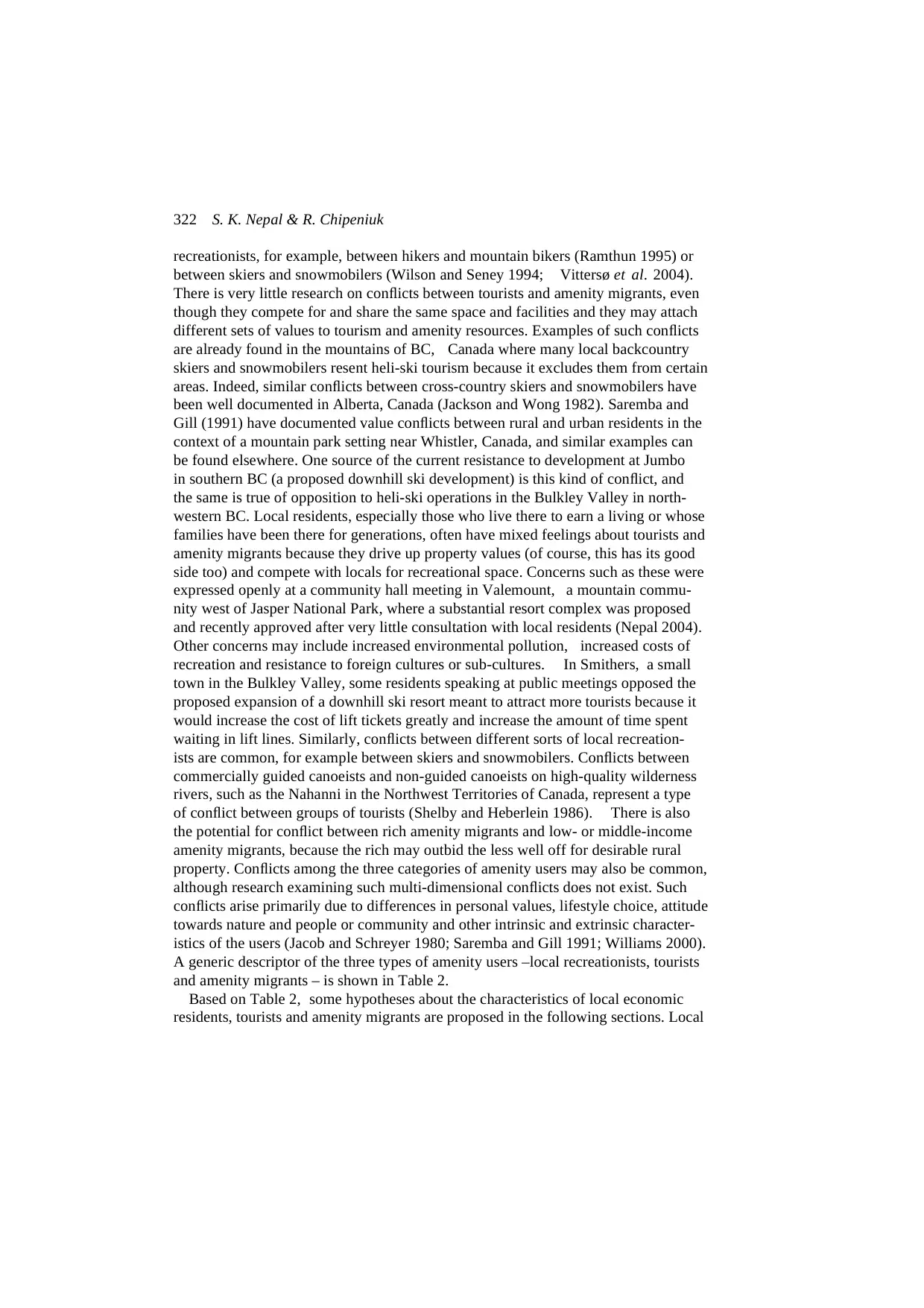
322 S. K. Nepal & R. Chipeniuk
recreationists, for example, between hikers and mountain bikers (Ramthun 1995) or
between skiers and snowmobilers (Wilson and Seney 1994; Vittersø et al. 2004).
There is very little research on conflicts between tourists and amenity migrants, even
though they compete for and share the same space and facilities and they may attach
different sets of values to tourism and amenity resources. Examples of such conflicts
are already found in the mountains of BC, Canada where many local backcountry
skiers and snowmobilers resent heli-ski tourism because it excludes them from certain
areas. Indeed, similar conflicts between cross-country skiers and snowmobilers have
been well documented in Alberta, Canada (Jackson and Wong 1982). Saremba and
Gill (1991) have documented value conflicts between rural and urban residents in the
context of a mountain park setting near Whistler, Canada, and similar examples can
be found elsewhere. One source of the current resistance to development at Jumbo
in southern BC (a proposed downhill ski development) is this kind of conflict, and
the same is true of opposition to heli-ski operations in the Bulkley Valley in north-
western BC. Local residents, especially those who live there to earn a living or whose
families have been there for generations, often have mixed feelings about tourists and
amenity migrants because they drive up property values (of course, this has its good
side too) and compete with locals for recreational space. Concerns such as these were
expressed openly at a community hall meeting in Valemount, a mountain commu-
nity west of Jasper National Park, where a substantial resort complex was proposed
and recently approved after very little consultation with local residents (Nepal 2004).
Other concerns may include increased environmental pollution, increased costs of
recreation and resistance to foreign cultures or sub-cultures. In Smithers, a small
town in the Bulkley Valley, some residents speaking at public meetings opposed the
proposed expansion of a downhill ski resort meant to attract more tourists because it
would increase the cost of lift tickets greatly and increase the amount of time spent
waiting in lift lines. Similarly, conflicts between different sorts of local recreation-
ists are common, for example between skiers and snowmobilers. Conflicts between
commercially guided canoeists and non-guided canoeists on high-quality wilderness
rivers, such as the Nahanni in the Northwest Territories of Canada, represent a type
of conflict between groups of tourists (Shelby and Heberlein 1986). There is also
the potential for conflict between rich amenity migrants and low- or middle-income
amenity migrants, because the rich may outbid the less well off for desirable rural
property. Conflicts among the three categories of amenity users may also be common,
although research examining such multi-dimensional conflicts does not exist. Such
conflicts arise primarily due to differences in personal values, lifestyle choice, attitude
towards nature and people or community and other intrinsic and extrinsic character-
istics of the users (Jacob and Schreyer 1980; Saremba and Gill 1991; Williams 2000).
A generic descriptor of the three types of amenity users –local recreationists, tourists
and amenity migrants – is shown in Table 2.
Based on Table 2, some hypotheses about the characteristics of local economic
residents, tourists and amenity migrants are proposed in the following sections. Local
recreationists, for example, between hikers and mountain bikers (Ramthun 1995) or
between skiers and snowmobilers (Wilson and Seney 1994; Vittersø et al. 2004).
There is very little research on conflicts between tourists and amenity migrants, even
though they compete for and share the same space and facilities and they may attach
different sets of values to tourism and amenity resources. Examples of such conflicts
are already found in the mountains of BC, Canada where many local backcountry
skiers and snowmobilers resent heli-ski tourism because it excludes them from certain
areas. Indeed, similar conflicts between cross-country skiers and snowmobilers have
been well documented in Alberta, Canada (Jackson and Wong 1982). Saremba and
Gill (1991) have documented value conflicts between rural and urban residents in the
context of a mountain park setting near Whistler, Canada, and similar examples can
be found elsewhere. One source of the current resistance to development at Jumbo
in southern BC (a proposed downhill ski development) is this kind of conflict, and
the same is true of opposition to heli-ski operations in the Bulkley Valley in north-
western BC. Local residents, especially those who live there to earn a living or whose
families have been there for generations, often have mixed feelings about tourists and
amenity migrants because they drive up property values (of course, this has its good
side too) and compete with locals for recreational space. Concerns such as these were
expressed openly at a community hall meeting in Valemount, a mountain commu-
nity west of Jasper National Park, where a substantial resort complex was proposed
and recently approved after very little consultation with local residents (Nepal 2004).
Other concerns may include increased environmental pollution, increased costs of
recreation and resistance to foreign cultures or sub-cultures. In Smithers, a small
town in the Bulkley Valley, some residents speaking at public meetings opposed the
proposed expansion of a downhill ski resort meant to attract more tourists because it
would increase the cost of lift tickets greatly and increase the amount of time spent
waiting in lift lines. Similarly, conflicts between different sorts of local recreation-
ists are common, for example between skiers and snowmobilers. Conflicts between
commercially guided canoeists and non-guided canoeists on high-quality wilderness
rivers, such as the Nahanni in the Northwest Territories of Canada, represent a type
of conflict between groups of tourists (Shelby and Heberlein 1986). There is also
the potential for conflict between rich amenity migrants and low- or middle-income
amenity migrants, because the rich may outbid the less well off for desirable rural
property. Conflicts among the three categories of amenity users may also be common,
although research examining such multi-dimensional conflicts does not exist. Such
conflicts arise primarily due to differences in personal values, lifestyle choice, attitude
towards nature and people or community and other intrinsic and extrinsic character-
istics of the users (Jacob and Schreyer 1980; Saremba and Gill 1991; Williams 2000).
A generic descriptor of the three types of amenity users –local recreationists, tourists
and amenity migrants – is shown in Table 2.
Based on Table 2, some hypotheses about the characteristics of local economic
residents, tourists and amenity migrants are proposed in the following sections. Local
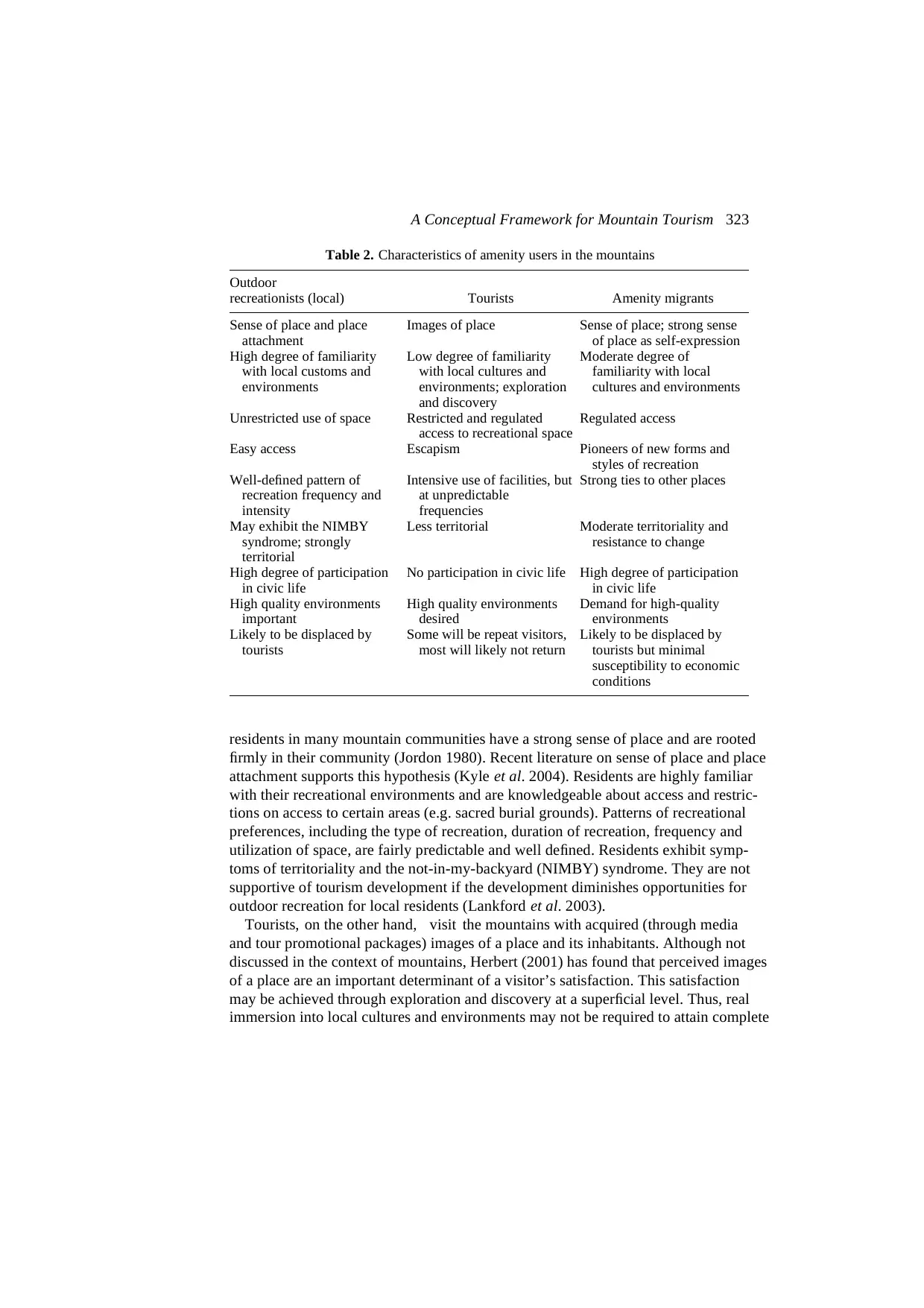
A Conceptual Framework for Mountain Tourism 323
Table 2. Characteristics of amenity users in the mountains
Outdoor
recreationists (local) Tourists Amenity migrants
Sense of place and place
attachment
Images of place Sense of place; strong sense
of place as self-expression
High degree of familiarity
with local customs and
environments
Low degree of familiarity
with local cultures and
environments; exploration
and discovery
Moderate degree of
familiarity with local
cultures and environments
Unrestricted use of space Restricted and regulated
access to recreational space
Regulated access
Easy access Escapism Pioneers of new forms and
styles of recreation
Well-defined pattern of
recreation frequency and
intensity
Intensive use of facilities, but
at unpredictable
frequencies
Strong ties to other places
May exhibit the NIMBY
syndrome; strongly
territorial
Less territorial Moderate territoriality and
resistance to change
High degree of participation
in civic life
No participation in civic life High degree of participation
in civic life
High quality environments
important
High quality environments
desired
Demand for high-quality
environments
Likely to be displaced by
tourists
Some will be repeat visitors,
most will likely not return
Likely to be displaced by
tourists but minimal
susceptibility to economic
conditions
residents in many mountain communities have a strong sense of place and are rooted
firmly in their community (Jordon 1980). Recent literature on sense of place and place
attachment supports this hypothesis (Kyle et al. 2004). Residents are highly familiar
with their recreational environments and are knowledgeable about access and restric-
tions on access to certain areas (e.g. sacred burial grounds). Patterns of recreational
preferences, including the type of recreation, duration of recreation, frequency and
utilization of space, are fairly predictable and well defined. Residents exhibit symp-
toms of territoriality and the not-in-my-backyard (NIMBY) syndrome. They are not
supportive of tourism development if the development diminishes opportunities for
outdoor recreation for local residents (Lankford et al. 2003).
Tourists, on the other hand, visit the mountains with acquired (through media
and tour promotional packages) images of a place and its inhabitants. Although not
discussed in the context of mountains, Herbert (2001) has found that perceived images
of a place are an important determinant of a visitor’s satisfaction. This satisfaction
may be achieved through exploration and discovery at a superficial level. Thus, real
immersion into local cultures and environments may not be required to attain complete
Table 2. Characteristics of amenity users in the mountains
Outdoor
recreationists (local) Tourists Amenity migrants
Sense of place and place
attachment
Images of place Sense of place; strong sense
of place as self-expression
High degree of familiarity
with local customs and
environments
Low degree of familiarity
with local cultures and
environments; exploration
and discovery
Moderate degree of
familiarity with local
cultures and environments
Unrestricted use of space Restricted and regulated
access to recreational space
Regulated access
Easy access Escapism Pioneers of new forms and
styles of recreation
Well-defined pattern of
recreation frequency and
intensity
Intensive use of facilities, but
at unpredictable
frequencies
Strong ties to other places
May exhibit the NIMBY
syndrome; strongly
territorial
Less territorial Moderate territoriality and
resistance to change
High degree of participation
in civic life
No participation in civic life High degree of participation
in civic life
High quality environments
important
High quality environments
desired
Demand for high-quality
environments
Likely to be displaced by
tourists
Some will be repeat visitors,
most will likely not return
Likely to be displaced by
tourists but minimal
susceptibility to economic
conditions
residents in many mountain communities have a strong sense of place and are rooted
firmly in their community (Jordon 1980). Recent literature on sense of place and place
attachment supports this hypothesis (Kyle et al. 2004). Residents are highly familiar
with their recreational environments and are knowledgeable about access and restric-
tions on access to certain areas (e.g. sacred burial grounds). Patterns of recreational
preferences, including the type of recreation, duration of recreation, frequency and
utilization of space, are fairly predictable and well defined. Residents exhibit symp-
toms of territoriality and the not-in-my-backyard (NIMBY) syndrome. They are not
supportive of tourism development if the development diminishes opportunities for
outdoor recreation for local residents (Lankford et al. 2003).
Tourists, on the other hand, visit the mountains with acquired (through media
and tour promotional packages) images of a place and its inhabitants. Although not
discussed in the context of mountains, Herbert (2001) has found that perceived images
of a place are an important determinant of a visitor’s satisfaction. This satisfaction
may be achieved through exploration and discovery at a superficial level. Thus, real
immersion into local cultures and environments may not be required to attain complete
⊘ This is a preview!⊘
Do you want full access?
Subscribe today to unlock all pages.

Trusted by 1+ million students worldwide
1 out of 22
Your All-in-One AI-Powered Toolkit for Academic Success.
+13062052269
info@desklib.com
Available 24*7 on WhatsApp / Email
![[object Object]](/_next/static/media/star-bottom.7253800d.svg)
Unlock your academic potential
Copyright © 2020–2025 A2Z Services. All Rights Reserved. Developed and managed by ZUCOL.